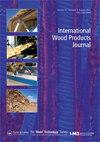富酚松针热解油改性酚醛树脂的制备及粘结强度评价
IF 0.9
Q2 MATERIALS SCIENCE, PAPER & WOOD
引用次数: 1
摘要
松针生物油部分被酚醛树脂(PF)取代,比例高达40%。新生产的生物油酚醛树脂(BOPF)在加入10%生物油的情况下,其木材粘接性能与纯PF树脂相当,且具有相似的剪切强度。DSC显示,20 wt-% BOPF树脂的固化温度从95℃降至60℃。根据TGA和DTG数据,BOPF树脂的热降解程度略低于纯PF树脂,并且在10%和20% BOPF树脂中相似。红外光谱分析表明,酚醛之间存在亚甲基桥,表明木材胶粘剂质量较好。通过扫描电镜观察,10%和20% BOPF树脂的微观结构与纯PF树脂相当。本文章由计算机程序翻译,如有差异,请以英文原文为准。
Preparation of phenol-formaldehyde resin modified with phenol-rich pine needle pyrolysis oil and assessment of bonding strength
ABSTRACT The pine needles bio-oil was partially replaced with phenol-formaldehyde (PF) resin at a rate of up to 40% by weight. The wood adhesive characteristics of a newly produced bio-oil phenol-formaldehyde (BOPF) resin with 10% bio-oil replacements was found to be comparable to those of pure PF resin with similar shear strength. DSC revealed that the curing temperature of 20 wt-% BOPF resin decreased from 95 to 60°C. Thermal degradation of BOPF resins was somewhat lower than that of pure PF resin, according to TGA and DTG data, and was similar in 10 and 20 wt-% BOPF resins. The presence of methylene bridges between phenols shown by FTIR analysis indicated that the wood adhesive had a good quality. According to SEM examination, the 10 and 20% BOPF resins showed a flat microstructure comparable to the pure PF resin.
求助全文
通过发布文献求助,成功后即可免费获取论文全文。
去求助
来源期刊

International Wood Products Journal
MATERIALS SCIENCE, PAPER & WOOD-
CiteScore
2.40
自引率
0.00%
发文量
27
 求助内容:
求助内容: 应助结果提醒方式:
应助结果提醒方式:


